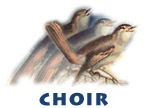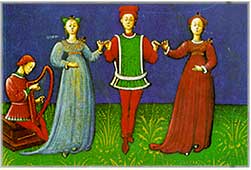

In a chronicle
written in the tenth century, the scribe Natan ha-Cohen, son of Yishaq ha-Bavli,
vividly describes the inaugural ceremony of Oukba, newly appointed head
of the Babylonian Jewish community. Babylonian Jewry is known to have enjoyed
internal autonomy for many generations before that time and the man who
was head of the community could always trace his ancestry back to the Kingdom
of David. The non-Jews looked upon him as the Persian king's representative;
in fact he ranked fourth in the Persian ruling hierarchy, which entitled
him to all appropriate pomp and circumstance. The announcement of the candidate
chosen was accompanied by the blowing of shofars, singing, and magnificent
ceremonies and parades.
R. Natahn ha-Bavli's
description of the inauguration attests to the perpetuation of ancient rites
and customs, while the rabbi adds that Oukba was a poet and musician "who
every day, throughout the year composed and performed his own paeans of
praise to the King." Further on, there is a description of the festive
Sabbath prayer held in honor of the community's new head:
 And
when he rises early on the Sabbath to go to the synagogue, many of the prominent
members of the community gather around to walk to the synagogue with him. In
good time the faithful had prepared a wooden tower for him seven cubits
high and three cubits wide and had draped it in pleasing cloth of silk
woven of blue and purple and crimson threads until it is altogether
covered and nothing can be seen of it.
Beneath it
gather young men chosen from among the leaders and notables of the community
and elders endowed with musicianship and with beautiful voices who are
well versed [in the prayers] and all about them… And the cantor
opens with, "Blessed art Thou" and the men respond after each
verse "Blessed art Thou, Blessed be He." And when he chants
the Sabbath psalm they respond after him: "It is good to give thanks
to the Lord" and the congregations chants verses of the psalms
in unison until they come to the end.
Then the cantor stands up and begins "and the soul of all that
lives and breathes" and the men respond: "Blessed by thy name."
He [the cantor] chants the words and the men answer until they reach
the Sanctification and all the congregation murmurs softly and the men
out loud and then they immediately become silent and the cantor continues
alone until "Israel be redeemed" and all the congregation
rises to pray.
When
he passes before the ark and comes to the Sanctification the men respond
with "The Almighty, blessed be He" in loud voice and the cantor
finishes the prayer and the congregation sits. After prayers all of
the people go out before him and after him extolling him with words
of homage until he reaches his house.
From
this description it becomes evident that a cantor and choir performed
those prayers that were sung. The choir's rile was mainly responsive,
the most usual form being antiphonal, the parts divided between the
cantor and the choir. For example: the cantor sings "A psalm
for the Sabbath day," and the choir responds, "It is good
to give thanks to the Lord;" the choir sings aloud while the
worshippers all murmur the prayer.

We also
learn that the choir was an established, trained group and included men
"endowed with musicianship and with beautiful voices who are well versed
[in the prayers] and all about them." Furthermore, they were chosen
from among the leaders and notables of the community," that is, for
elite families. There were also other songs and liturgies, less sophisticated
than those sung by the cantor and choir. They were apparently of a more
popular folk character and were sung by all of those who took part it he
processions.
|
 Amnon
Shiloah, Jewish Musical Traditions, Wayne State University Press,
Detroit, 1992; pages 45, 46. Amnon
Shiloah, Jewish Musical Traditions, Wayne State University Press,
Detroit, 1992; pages 45, 46. |
CHOIR Table of Contents
|